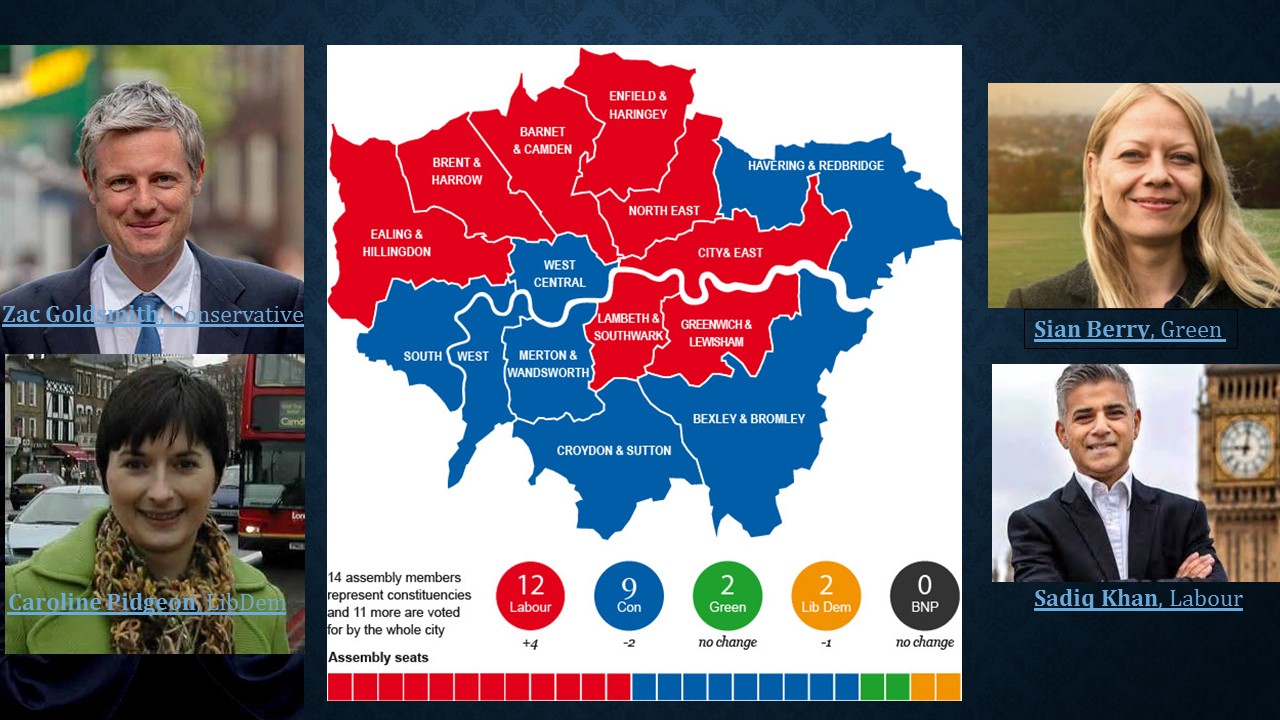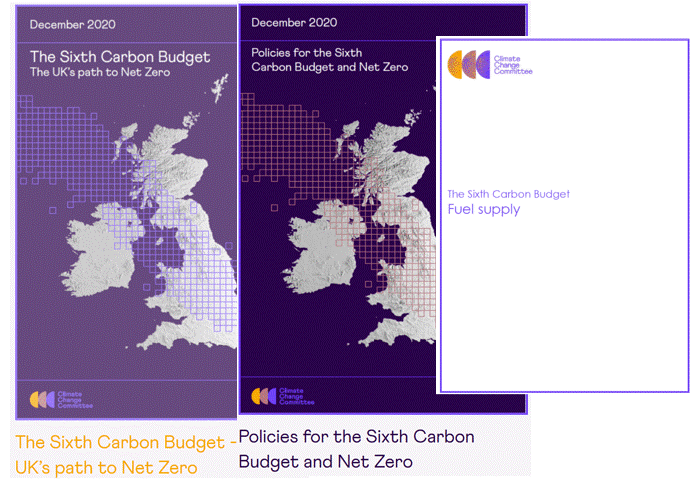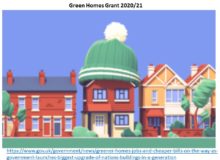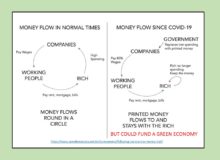Will the New London Mayor reduce Air Pollution and slow Global Warming?
Sources: Map from May 2012 BBC report, pictures from election material
The new London Mayor will have a variety of powers that would help him/her clean our polluted air and lower our carbon emissions. Many powers are ‘soft’ ones such as ‘influence’ and ‘promotion’, but they also include the power of £11.5bn expenditure (p21 of the draft GLA 2016/17 budget being prepared for the new Mayor). Apart from (limited) powers over areas such as Transport and Planning the Mayor will be constrained by UK, EU powers and existing agreements and the candidates can only state their aspirations and ideas at this point, to try to convince London voters that they are the best candidate. The winner will have to try to turn rhetoric into results by dint of their limited powers, their procurement muscle and their leadership and influence skills .
This post has samples from the public domain of statements and promises from the four frontrunners Sian Berry – Green; Zac Goldsmith – Conservative; Sadiq Khan – Labour and Caroline Pidgeon – LibDem, regarding Global Warming and Climate Change; Renewables and Community Energy and Low Pollution Transport. It also has responses to Greenpeace’s questions to the Mayoral candidates at Sadiq Khan, Zac Goldsmith, Caroline Pidgeon..
A summary transcript of the Green Alliance’s Green Hustings. (1hr 34mins) is also included at More.
Global Warming and Climate Change
London signed the Paris Pledge for Action during the Paris COP21 in Dec 2015, These promises include:
“Reduce community-wide CO2e emissions by 60% from 1990 to 2025”
“USD 610m green bonds issued for projects in low carbon transport in United Kingdom of Great Britain and Northern Ireland by the Transport for London (TfL)”
And previously London had made promises to tackle Climate Change with the Non-State Actor Zone for Climate Action (NAZCA).
The actions to achieve these promises are proper to the London Plan. The current version at Ch 5: London’s Response to Climate Change at policy 5.1 states that:
“The Mayor seeks to achieve an overall reduction in London’s carbon dioxide emissions of 60 per cent (below 1990 levels) by 2025.” ….. “On a business as usual basis it is expected that annual carbon dioxide emissions will actually fall to 40.34 million tonnes by 2025 (a 10 per cent decrease on 1990 levels)”. These dramatic reduction will need to come from changes from buildings using less gas and electricity, increases in the use of clean power and replacing ‘dirty’ transport with ‘clean’ transport.
In effect the solutions, to the transport problem in particular, are very similar to the solutions to Air Pollution problems. The candidates’ acknowledgement of their role in the Global efforts to reduce Global Warming and Climate Change include:
Sian Berry’s proposed London Energy Company will help to deliver at least 30 percent of London’s energy needs from zero- or low-carbon sources by 2030.”
Zac Goldsmith has published a ‘Living Environment Manifesto’ that includes: “Source 25% of London’s energy from “low carbon sources” by 2025, with the aim of reaching 100% by 2050.”
Sadiq Khan has published ‘A Greener Cleaner London’ that includes “Set a target for London to become a zero-carbon city by 2050 – this means running on 100% carbon free sources.” and to “Ban fracking in London.”
On the Global front Sadiq also promises to “Take all possible steps to divest the London Pension Fund Authority of its remaining investments in Fossil Fuels”
Renewables, Energy Efficiency and Community Energy
Power stations must be largely decarbonised and more low carbon power must be produced locally, according to the National Infrastructure Commission (NIC) in its first report Smart Power in March 2016. Its Future Power Sources schematic shows how power will become more localised and 2-way. The report also covers the increase in the use of electricity for heat and transport and the new requirements to match demand management and local use and storage with production peaks and troughs.
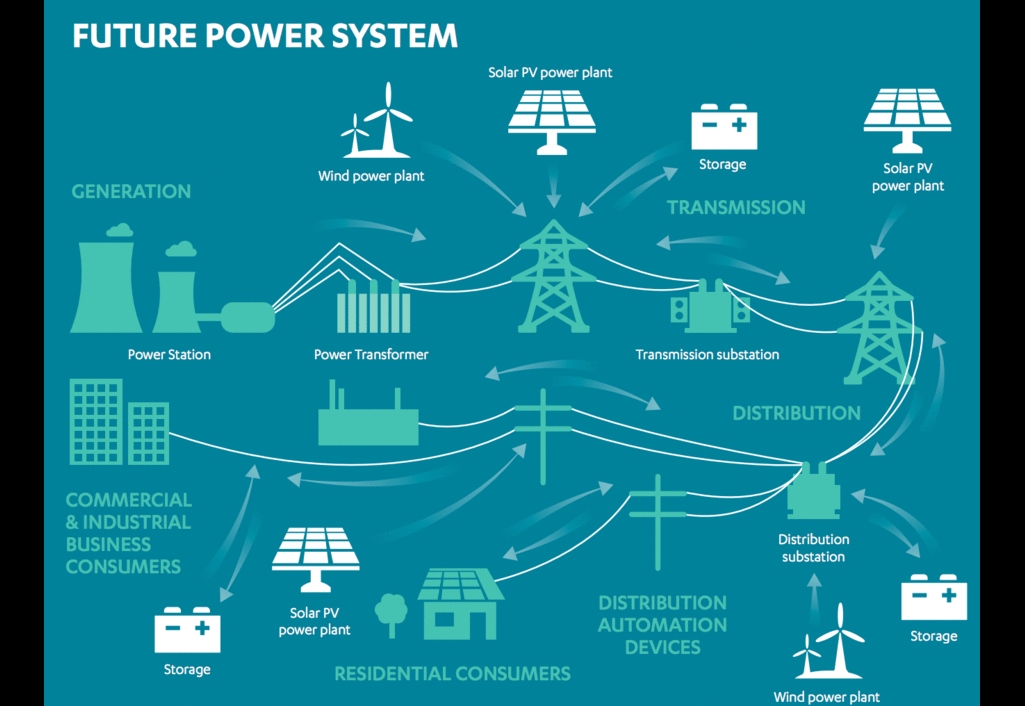
source: Smart Power from the National Infrastructure Commission
The potential for London to reduce carbon emissions from power and reduce the demand for energy from efficiencies are the subjects of Greenpeace’s London Can’t Wait for Solar – How the new Mayor of London can start a Solar Revolution in 2016 that reported that “London could generate 20% of its own energy from solar alone. “The report covered ‘RE:NEW’- the Mayor’s domestic energy efficiency programme; ‘RE:FIT’ – the Mayor’s non-domestic retrofit programme; the potential of the TfL estate and the implications of GLAs ‘licence lite’ to purchase electricity generated in London. It also details shortfalls in Solar generation across London so far and proposes several ways to catch up. The candidates’ statements on intentions to increase renewables, energy efficiencies and to support Community Energy include:
Sian Berry’s approach to boosting London’s renewables encompasses the GLA electricity licence and Greenpeace’s ideas about using TfL properties. She discusses the London Energy Company. “I will set up a new London Energy Company to ensure that Crossrail is powered by 100% clean electricity…… the first step towards a renewable energy revolution. By developing other renewable technologies and buying from wholesale markets, the company will help to deliver at least 30 percent of London’s energy needs from zero- or low-carbon sources by 2030.” The company would “start by putting solar panels up across TfL’s own 5,700-acre estate of stations, depots, offices, other commercial units and brownfield sites. It will go on to put them on large commercial roof spaces across the capital and on solar farms on London’s fringe, and it will work with community groups, the public sector and businesses to generate low-cost renewable energy from a variety of sources across the capital.”
And: “There is huge potential in London for a wide range of low- and zero-carbon technologies to be used to generate heat and electricity from the sun, the wind, the ground and air using heat pumps, gas created from waste, and from London’s tides and river flows. “
Zac Goldsmith echoed proposals in the Greenpeace paper in his Plan to Make London the Greenest City on Earth and promised “a revolution in solar energy – with a tenfold increase in solar power & at least 200,000 London homes solar-powered by 2025” In Zac’s “Living Environment Manifesto he promises to:
“Set up a new clean energy company which will buy energy from low carbon generators across London and sell it to businesses and housing estates.”
“Generate 10% of London’s energy from solar by 2025” and “Source 25% of London’s energy from “low carbon sources” by 2025, with the aim of reaching 100% by 2050.”
“Work with developers to include solar generation in new build flats and houses”
“Explore potential for building ultra-efficient homes capable of producing 75-100% of their energy”
“Ensure that “large developments on publicly-owned land will come with solar panels by default.”
“Give community energy co-operatives the right to generate solar power from under-used public space, such as the roofs of bus stops and sports halls.”
“Help community energy co-ops set up their own green energy projects, with a new programme of ‘Solar Powered Estates’.”
“Match community energy projects with investor finance”
Sadiq Khan also echoes Greenpeace proposals in A Greener Cleaner London by saying that he would establish a company called “Energy for Londoners… support local and community energy enterprises, and buy clean energy generated across the city, using it to power GLA and TfL facilities.” The company would provide “advice and support to those wanting to set up community energy projects, and acting as a dating service for those wanting to be part of a community energy projects with commercial premises with space for solar panels.”
For energy generation and energy efficiency Sadiq also promises to:
“Make the most of the city’s roofs, public buildings and land owned by TfL for energy generation by producing a solar energy strategy.”
“Ensure low carbon, energy efficiency and sustainability standards for new developments and increase renewable energy generation on social housing.”
Energy for Londoners would be “a not-for-profit company providing a comprehensive range of energy services to help Londoners generate more low-carbon energy and increase their energy efficiency”
Caroline Pidgeon, at the Green Alliance hustings (see below) mentioned possibly introducing a London Feed-in Tariff, establishing a “solar task force” to audit the GLA’s property estate, and challenging large private organisations to adopt solar, especially on industrial estates.
Low Pollution/Low Carbon Transport
As well as electricity and heat, the bulk of London’s carbon emissions come from Transport, and this is also a major culprit for London’s polluted air. Solutions include persuading Londoners to walk and cycle more and to target the most polluting vehicles and roads with the worst pollution.
For Vehicles TfL’s July 2015 Ultra Low Emissions Vehicle (ULEV) Delivery Plan for London explains (atp3) that the Ultra Low Emission Zone (at App 4) would be “transforming London’s public and commercial fleets; delivering zero emission taxi and private hire fleets; transforming London’s bus fleet; and an action on ‘Driving the uptake of Low Emission Vehicles’, but it explains that it depends on the Mayor, TfL, the London boroughs, the government, the EU and other parties to bring this about. TfL has funds to provide £65 million to help drivers buy new greener cabs five years before their old ones are out of date, according to LowCVP.
The Plan says that “ULEVs can help to improve air quality and reduce CO2 emissions in London BEVs and FCEVs emit no pollution at the point of use, and PHEVs and RE-EVs emit no pollution at point of use when in electric mode.” (BEVs are Battery electric vehicles, PHEVs are Plug-in hybrid electric vehicles, RE-EVs are Range-extended electric vehicles, FCEVs are Hydrogen fuel cell electric vehicles). However the report does not cater for the pollution dangers from Diesel transport, as noted by the London Assembly’s Environment Committee in Oct 2015. Also it does not recognize that, as petrol/diesel power is replaced by electric power, the need for renewable clean power will increase, and will need to match the battery charging needs of electric vehicles.
For Cycling a Mini-Holland scheme is a current TfL trial in Enfield, Kingston and Waltham Forest to “encourage more people to cycle, more safely and more often while providing better streets and places for everyone. The programme will specifically target people who make short car journeys in outer London that could be cycled easily instead.“
In April 2016 a poll by Greenpeace established that 62% of Londoners would back a Clean Air Zone including a strong majority of car owners. Leaders from the Cycling and Taxi communities recently signed a proposal for a large city-wide Clean Air Zone that will phase out the most polluting vehicles off the roads.
Sian Berry promises for the Ultra Low Emission Zone (ULEZ) from her No more delays on clean air post are that she would “immediately exclude the most polluting cars, vans and lorries from central London. I will cancel road-building plans and oppose all airport expansion and…….. speed up replacing diesel buses with hybrids and electric vehicles……In the longer term, we need a truly effective new Ultra Low Emission Zone, much stronger car-free policies into the London Plan, and a new electric car charging network with at least 25,000 charging points for cleaner vehicles, including the new taxis.”
Regarding Air Pollution Monitoring and reduction of harm she would: Ensure that air pollution is monitored and properly publicise the data so that people can better protect their health, for example by cutting car use and avoiding outdoor exercise when high pollution levels are anticipated or registered.
Provide support through air quality funds for local communities to carry out their own monitoring exercises, helping improving public understanding and identifying hotspots that need urgent action from Transport for London and their local authority.
Help to develop and install more continuous monitoring equipment together with innovative ways of providing public displays of real-time air pollution data on the streets
Make sure all schools, retirement homes and daycare centres are able to develop air pollution action plans to respond to high pollution episodes.
Regarding Airport pollution Sian says in her No to all new runways in London – at Gatwick not just Heathrow that she “would lobby for the reformed aviation tax promoted by the A Free Ride campaign. This would reduce the amount paid in flight taxes by almost everyone, by giving each person one trip a year free of tax, but would charge the most frequent flyers a suitably increased rate with each extra trip.”
Sian also opposes City Airport in Our Plan to Redevelop the London City Airport she says that: “Pollution-related death rates around the airport are among the highest in the country, and ‘crash zone’ rules are preventing development in the local area…. all for the sake of a TINY number of passengers. Sian proposes replacing London City Airport with a new housing and business quarter for Londoners.
Zac Goldsmith promises on an Ultra Low Emission Zone (ULEZ) in his Environment Manifesto (p12) says that he will ensure that “London is pollution free as soon as possible, including backing the Ultra Low Emission Zone.”
In London Needs Electric Cars Zac says that “Despite a range of Government tax breaks and a promise from Boris to hit 100,000 electric cars by 2015 Londoners currently own just 3,000 electric cars”. He would “Drive up use of electric cars by supporting a pan-London and ambitious “Boris Bike” equivalent for electric cars.” He also says that he would “Enforce the London Plan’s existing requirement that 1 in every 5 new car parking spaces in major developments should be electric. Zac will also support more boroughs following Westminster’s example and providing free parking for electric cars.”
Zac would also explore ‘BMW’ charging lampposts; all new taxis will be electric from 2018, and all buses electric or hybrid two years after that.
Regarding Airport pollution Zac’s web page Opposing Heathrow Expansion says that “For many years, Zac has been at the forefront of the campaign against the proposed 3rd runway at Heathrow…. An extra runway would also add 300,000 additional flights and 25 million more car and lorry journeys a year, creating illegally high levels of pollution in the capital.”
Sadiq Khan would “Maintain the Congestion Charge at its current level” according to A Modern and Affordable Transport Network and, in the Green Hustings he promised to expand the Ultra Low Emission Zone and identify the most polluted routes to be provided with the cleanest buses.
Sadiq called on Ministers in March 2016 to introduce a diesel scrappage scheme to help clean up London’s air.
Regarding ‘clean’ vehicles Sadiq said he would “Deliver the electric charging infrastructure, in partnership with the private sector, necessary for a major expansion in the use of electric vehicles” in A Greener Cleaner London. Sadiq also supported “Car Clubs as a means of reducing congestion and demand for parking in A Modern and Affordable Transport Network.
Regarding Airport pollution Sadiq says in A Greener Cleaner London that he would “Oppose the construction of a third runway at Heathrow Airport.“ On his Transport manifesto page Sadiq says that “As Mayor of London I will back Gatwick and deliver the projects we need to be a global city. “
Carolyn Pidgeon would “Add an additional charge of £12.50 on diesel vehicles using the Congestion Charge Zone” in the Gridlock Plan and that the “Introduction of an additional levy on the Congestion Charge could be a ‘game changer’ in tackling London’s appalling air pollution” on her web site. Her fellow Lib Dem Liberal Democrat AM Mr Knight said in Sept, according to Air Quality News that “Euro 6 diesel cars should not be allowed to enter the planned Central London ULEZ as real-world emissions tests show higher emissions from diesel cars than in laboratory tests.”
Regarding electric vehicles Caroline said in August 2011 on her web site that “A Big Switch to electric buses and taxis can cut London’s appalling air pollution, dramatically reduce premature deaths and ill health, and help meet climate change targets. The London Assembly Liberal Democrats have put forward an ambitious programme to convert high mileage buses, taxis and light goods vehicles to electric power by 2020.”
Regarding Cycling Caroline said on her web site that “I want to make sure that every part of the capital is great for people to cycle in, and that it feels safe for people to cycle. I want to carry on the cycle superhighways – even the controversial bits – but I also want to look at outer London, because I think that there’s a real opportunity there to get more people out of their cars and on to bikes for those shorter trips.”
Regarding Airport Pollution Caroline’s web site reports a Huffington Post article “We need a better run Heathrow, not a bigger Heathrow. We need to start making much better use of the surprisingly large spare runway capacity at airports in the South East, especially Stansted. And we need to also recognise that there are plenty of business people living in the Midlands and the North of England who resent being forced to always first fly to Heathrow before they can first start an international flight.”
Greener London Hustings
The Green Alliance hosted the Greener London Hustings on 4th March 2016 offering an opportunity for the top four London mayoral candidates to answer questions on Green London Issues. The hustings can be listened to here: and a summary of the topics and their answers follow:
Candidates:
Zac Goldsmith, Conservative
Caroline Pidgeon, LibDem
Sian Berry, Green
Sadiq Khan, Labour
Air quality: phasing out diesel taxis & hire vehicles, buses on clean fuel? (@ 15.10 mins)
Zac: yes, & retrofit older taxis (£6,000 each), buses ULEZ compliant
Caroline: yes, & help taxis by leasing/ subsidising electric versions/bulk buying/better electric charging points/charging diesels in central zone.
Sian: yes, & retrofit & leasing, also new congestion charging system so that fewer cars.
Sadiq: MPs recommended scrappage scheme for diesel vehicles, ULEZ to be expanded, improve charging infrastructure, pedestrianize Oxford St (300 buses per hour at present).
Protecting schools & hospitals from pollution? (@ 24.40 mins)
Zac: make sure work vehicles retrofitted
Caroline: more tree planting, bring forward ULEZ
Sian: extend clean air zones round buildings, extend mini-Holland schemes.
Sadiq: bike spaces for hospitals, extend “walking to school” routes, TfL “walking champions”.
Commit to walking first? (@ 32.54 mins)
Zac: more “pocket parks”, expand mini-Hollands with public support (Enfield not working because no public involvement).
Caroline: better traffic crossings, pedestrianize Oxford St & all Soho, support Play Areas
Sian: expand mini-Hollands, levy on supermarkets to donate to town centres
Sadiq: more Green Corridors, expand King’s Cross type areas – though difficult when privately owned.
Safer cycling? (@ 40.44 mins)
Zac: sort out junctions, HGVs should be removed at school hours – improve consolidation centres
Caroline: agree, & increase cycling budget, engage communities
Sian: agree, & continue funding for super highways
Sadiq: agree, consolidation effective during Olympic Games, & more quiet ways, planning for storage, hire, & flyovers for cycles.
Commit to Solar City (10 fold increase) – 1% at present? (@ 51.03 mins)
Zac: still 5% return on solar, tariffs determined by EU, new planning should make roof space available (as in Bristol)
Caroline: audit all GLA buildings, including Fire & Police, also large retailers
Sian: London behind other regions, should be 30% solar
Sadiq: King’s Cross gets 10% solar energy, agree GLA properties & design of new buildings, encourage local initiatives (as in Brixton).
Give low income families warm efficient homes? (@ 58.18 mins)
Zac: create a market, can encourage private landlords but not compel, housing associations?
Caroline: target areas where problems – landlords can claim against tax.
Sian: create register of private landlords, regulate rents and letting standards.
Sadiq: create not-for-profit letting agency (done successfully in Nottingham).
Green spaces? (@ 1hr 09.12 mins)
Zac: Create “Tsar” to maintain green areas, vision of National Park City good, but not garden bridge. Clean up Thames. Note that Sadiq has voted to build on Green Belt and for Heathrow expansion.
Caroline: agree to Tsar with clout, & National Park City, protect Green Belt, not garden bridge (£60million of which £30million from govt – should go to parks)
Sian: agree to Tsar in order to deal with different agencies, & National Park City.
Sadiq: no separate Tsar, ?garden bridge
Recycle 50% of waste? (@ 1hr 14.15 mins)
Zac: LAs responsible but single set of standards over whole GLA, make producer responsible, work towards zero waste city.
Caroline: LAs do it best, but can have dedicated recycling in transport network.
Sian: Mayor could co-ordinate systems & encourage reduction, eg single use plastic bottles.
Sadiq: have ambitious recycling target, no more incinerators
The Green Alliance “is now the leading UK think tank working on environmental policy and politics“. They have also published a ‘Greener London’ publication discussing their ideas for the new Mayor.
London belongs to the C40 network, “which surveys the Mayoral Powers of its member cities in order to understand where the greatest opportunities exist to advance specific climate actions.” The schematic illustrates strong powers over Transport and main roads, with few powers over many other areas.
Only time will tell as to whether the New Mayor will clean London’s Air and help to slow Global Warming. The Manifesto promises from Boris Johnson for the 2012 election are here for perusal. Clean Air London have issued their own challenge to the New Mayor at Clean Air Manifesto 2016 and intend to track the performance of the new Mayor against 10 pledges.

